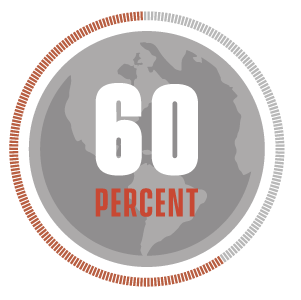A GROWING GLOBAL DEMAND
It’s no secret that our world is undergoing a period of rapid, transformational change. As the human population continues to rise globally, eclipsing 7.5 billion people in 2019, demand for resources to feed, clothe, house, and employ our growing numbers will expand as well.
Pursuit of economic opportunity, from the individual to the national level, is likely to further drive megatrends such as globalization, industrialization, and urbanization, particularly in the developing world. Therefore, meeting our collective needs in today’s society means increased interconnectivity and interdependence in how we live and work.
From our infrastructure to our smart phones, the tools and systems that are essential to modern life are increasingly technical, sophisticated, and ubiquitous. You can learn more about the resource demands needed to build and maintain our infrastructure, such as roads, bridges, railways, airports, and buildings, in our recent blog post on Construction Aggregates.

By 2030,
60% of the world populationwill live in cities and urban areas.
Disruptive Forces, Disruptive Innovation
On the positive side, this century has brought rapid advances in technologies such as automation, artificial intelligence, robotics, analytics, and the IOT (Internet of Things). These innovations are disrupting the way resources are produced and consumed. In many instances these advancements have ‘flattened’ the world and reduced barriers to participation, enabling ideas and talent to rise from the developing world to compete in the global marketplace.
However, complex systems like our societies and economies can produce complex challenges, none greater than the issue of climate change that threatens the future viability of all life on Earth. Thankfully human ingenuity and progress continue to overcome each hurdle we encounter. Innovations and the companies that bring them to market are fueling a revolution in how we respond, adapt to, and mitigate challenges such as climate change. Even energy companies that have built their business on fossil fuel production and consumption are beginning to plan for the energy shift of the future.

Renewables
Accounted for 45%of global Electricity generation growth in 2018.
Confronting challenge creates opportunity
Technological advances coupled with policy changes will continue to make renewable energies such as solar and wind energy cost-competitive with fossil fuels. Renewable energy production and adoption will also increase with the advancement of storage technology, which will help expand renewables role in the global economy’s energy mix.
Consumer trends like the advent of electric and self-driving vehicles and ride sharing, plus greater use of energy-efficient technologies in factories, businesses, and homes will reshape the future demand for resources. In fact, it was recently estimated that it takes approximately 38,000 pounds of new mineral resources per person per year to produce the goods we require for daily life.
Consumption of metals also continues to increase year over year, which depletes existing supply and necessitates discovery of new sources to replenish what is used. In turn, resource producers will be able to deploy a range of technologies in their operations, being able to access resources that were once unattainable. These technologies will also help producers improve the safety and efficiency of extraction techniques while reducing environmental impacts, and using sophisticated data analysis to better target, extract, and utilize resources.
38,000 lbs.
of minerals neededfor every person in the U.S. per year.
Follow the minerals: Iphone Case Study
Part of our business strategy is taking a high-level view of industries and sectors that rely heavily on the strategic minerals we’re exploring for. Technology companies make up a significant portion of the global economy, and therefore it’s no surprise their products such as the iPhone contain numerous specialized components made from even more numerous raw materials.
By breaking down the iPhone into its constituent components we can identify where in the supply chain certain manufacturers are positioned, and then evaluate the nature of their sourcing and pricing. This level of analysis also helps us track the flow of capital investment to various projects and forecast the fluctuating demand for commodities based on regional scarcity or abundance.

Countries
Manufacturers
Minerals
35 Minerals
Deemed "Strategic & Critical"to U.S. National security & Economic Prosperity
Strategic and Critical
The United States is heavily reliant on imports of certain mineral commodities that are undersupplied or unavailable from domestic sources. Many of these minerals are vital to the Nation’s security and economic prosperity, therefore a dependency on foreign suppliers creates a strategic vulnerability for both the U.S. economy and military to hostile foreign actors, natural disasters, and other supply chain disruptions.
Expanding global development presents a challenge of balancing cooperative and competitive forces so that the maximum number of people have access to opportunity given limited resources. It also offers the business community opportunities and challenges as well, not only in the form of products and services that support this development but by the fact that new consumer segments are being created and a corresponding demand for new products is being generated.
Taken in sum, global population growth, urbanization, economic development, and technological innovation will guarantee that minerals remain a central and vital part of life on our planet, today and into the future. It is up to us to ensure that the exploration, discovery, and development of these natural resources is done so in a sustainable way that protects our planet and creates enduring value for society.
LEARN MORE
What makes a mineral “strategic and critical”? Why is mineral exploration crucial to our national security? Make sure to read our next blog post all about strategic and critical minerals.
Why Minerals are the future
“Responsible exploration and development of Earth’s resources has never been more critical to human life and well-being. We must find and utilize these materials without compromising the sustainability of our planet’s natural systems.”
Brian Lentz, Vice President

2020 © Exsolve, Inc.
info@exsolvetech.com
